Diyarbakir, a city steeped in history and culture in southeastern Turkey, is renowned for its culinary scene, and if there’s one dish that reigns supreme, it’s liver. During our travels to this ancient metropolis, we embarked on a quest to uncover the “best liver,” a seemingly straightforward mission that quickly revealed itself to be delightfully complex. Trying to pinpoint the ultimate liver experience in Diyarbakir is akin to searching for the perfect pizza slice in New York City – a matter of personal taste and endless, delicious options. Instead of chasing an impossible superlative, we immersed ourselves in the city’s vibrant “Liver Street” culture, savoring a diverse range of flavors and experiences.
Our exploration began near the entrance to Sur, Diyarbakir’s ancient heart, known as Amed in Kurdish. Sur is a place where time whispers from every stone, its history stretching back to 7500 BC. Empires have risen and fallen within its walls, from the Hittites and Persians to Alexander the Great. The imposing city walls (surlari), millennia old, stand as silent witnesses to centuries of stories. Until 2015, Sur was predominantly inhabited by Kurdish people, a vibrant, albeit historically marginalized community, rich in cultural heritage. Within its ancient walls, mosques stood alongside churches and synagogues, bearing testament to the diverse tapestry of Armenian and Jewish populations that once thrived there.
However, 2015 marked a turning point for Sur. Turkish armed forces descended upon the district to suppress an uprising ignited by the breakdown of peace negotiations between the Turkish government and the Kurdistan Workers’ Party (PKK), alongside the tragic assassination of peace advocate lawyer Tahir Elci in the city center. The ensuing conflict devastated Sur, obliterating two of its seven neighborhoods and inflicting severe damage upon the rest. Surp Giragos, Diyarbakir’s magnificent Armenian cathedral, was reduced to a mere skeleton of its former glory.
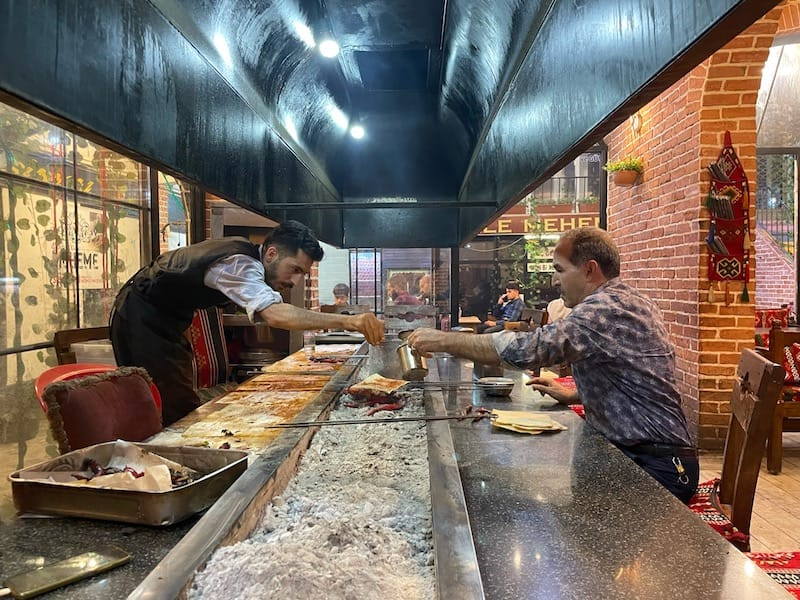
Image alt text: Expert hands of Halil Usta preparing succulent Diyarbakir liver at Cigerci Xale Meheme, showcasing the mastery behind Turkey’s renowned liver street food.
While the Turkish housing agency, TOKI, has since undertaken reconstruction efforts, the new buildings, resembling generic middle-American shopping malls, stand in stark contrast to the area’s historical character. This incongruity has sparked local protests and stalled further construction. Yet, amidst the changes, some enduring gems of Sur’s past remain, including Cigerci Xale Meheme, our first stop on our immersive liver tour.
Cigerci Xale Meheme: A Legacy of Liver Mastery
Liver preparation in Diyarbakir is an art form, presided over by ustas, or masters of their craft. Meheme Usta was a legend in this realm, revered as one of the best. Though he is no longer with us, his culinary heritage lives on at Cigerci Xale Meheme, a restaurant imbued with the smoky aroma of charcoal and spices, now run by his devoted apprentices. We arrived straight from the airport, close to 10 p.m., and our entrance caused a stir. The restaurant was filled with local Kurdish men, and we were clearly outsiders. However, any sense of being out of place quickly dissolved as we were warmly welcomed. Hasan, our server, insisted we take seats right by the open charcoal grill, declaring it “the best seat here.”
Halil Usta, continuing Meheme’s tradition, expertly prepared the liver. He selected generous, fresh chunks of liver and fat from a container, liberally coating them in a secret blend of pepper and spices. Freshness, he emphasized, is paramount to achieving the signature sweetness and tenderness of Diyarbakir liver. He meticulously threaded the seasoned liver and fat onto metal skewers – a piece of liver followed by a piece of fat – before placing them over the fiery coals, alongside vibrant green peppers and juicy tomato halves. As the liver sizzled, fat dripped onto the coals, creating flavorful smoke, and Halil generously brushed the skewers with butter and oil. Diners watched with anticipation as the liver cooked to perfection, already armed with wet naps (islak mendil) in eager preparation.
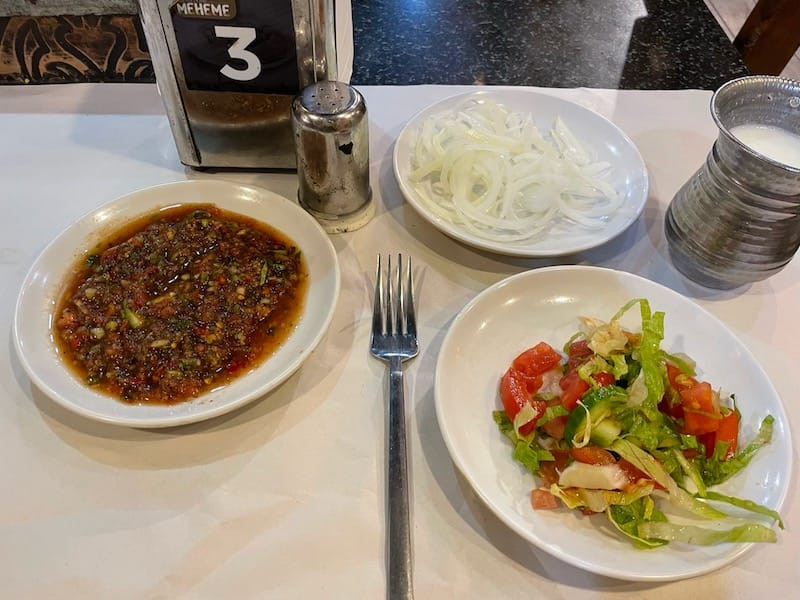
Image alt text: Close-up shot of Halil Usta grilling succulent liver skewers at Cigerci Xale Meheme, highlighting the traditional cooking method that defines Diyarbakir’s famous liver street.
In a final flourish, Halil enveloped the cooked skewers in fresh lavas bread, allowing it to absorb the flavorful juices and spices. Using the flatbread like a protective glove, he skillfully pulled the grilled liver off the skewer. With hands adorned with silver rings, he presented us with the steaming roll of liver encased in fresh bread. Our anticipation reached its peak. We added sumac-spiced onions, already waiting on the table, atop the meat, and seasoned it lightly with salt.
The first bite was transformative. The liver was exquisitely sweet and tender, the spices and rendered fat creating a delightful crispy exterior. Spicy oil trickled down our hands onto the paper placemats. We devoured the first roll in moments, followed swiftly by a second. We even persuaded Halil to let us assemble our third porsiyon ourselves, this time opting to forgo the bread to fully appreciate the liver – even crispier this round. Satiated, perhaps excessively so, we strolled back to our hotel through the dimly lit streets, the sodium lamps casting long shadows.
Umut Ciger: Morning Liver Disappointment
Following Halil Usta’s advice that liver is excellent any time but particularly fresh and flavorful in the morning, we set out early the next day for our first liver breakfast. We ventured just outside the Sur city walls to Umut Ciger, a seemingly unassuming restaurant. Despite Halil’s morning freshness promise, Umut Ciger proved to be a slight letdown after the previous night’s exceptional experience. The liver at Umut was noticeably drier and cut into smaller pieces. While the accompanying sides – sumac and isot-coated onions, fresh tomatoes, and herbs – were delectable, the liver itself lacked the melt-in-your-mouth tenderness of Halil’s, with a faint hint of blood betraying its slightly subpar quality, according to Halil’s standards.
Cigerci Remzi Usta: A Fortress of Flavor
That evening, we sought redemption. Returning late from our reporting duties, we found most of the recommended liver spots, many located in Diyarbakir’s bustling covered market, already closed. Hesitantly, we made our way back to Sur and Cigerci Remzi Usta, one of the old city’s most renowned establishments. When it comes to restaurants, we often gravitate towards the unassuming, even slightly rough-around-the-edges places, over the overtly flashy. Remzi Usta, however, was anything but unassuming.
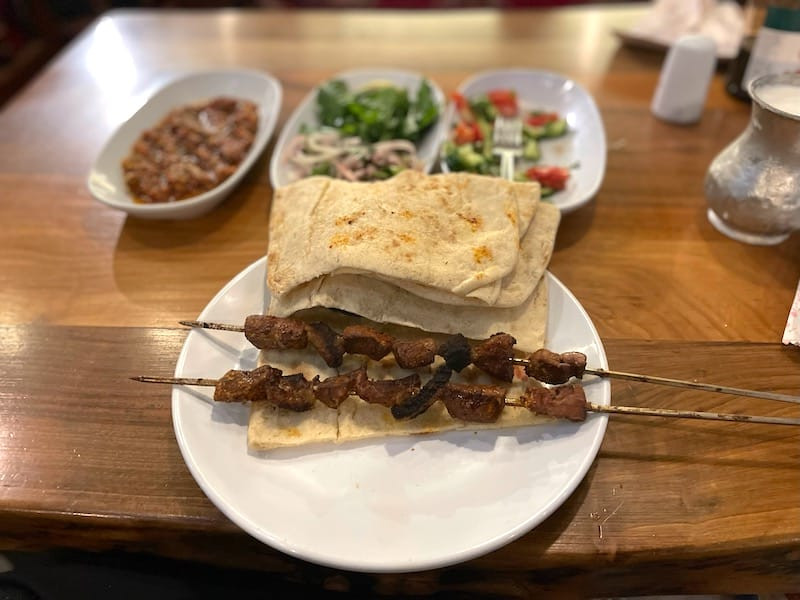
Image alt text: The grand facade of Cigerci Remzi Usta, a prominent liver restaurant in Diyarbakir, showcasing its well-lit and inviting ambiance on the city’s renowned liver street.
Located down a brightly lit alleyway, a characteristic feature of Sur, especially before the conflict, Remzi Usta was a sprawling three-story complex, adorned with illuminated signs and staffed by waiters in matching uniforms. It resembled a castle, or at least a culinary fortress. A glowing sign proclaimed “I ❤️ Ciger,” leaving us somewhat skeptical.
Despite our initial reservations, our expectations were pleasantly defied. When two skewers of steaming liver arrived – we had ordered modestly – we were genuinely surprised. The seasoning was impeccable; unlike other places where we felt the need to add salt to balance the liver’s natural sweetness, Remzi Usta’s was perfectly seasoned. The spices generously coated the meat, cut into slightly smaller pieces than those at Xale Meheme. While the meat wasn’t quite as tender, we couldn’t definitively attribute this to the restaurant itself or the later hour (Halil’s morning freshness warning lingered in our minds). The liver accompaniments – isot and sumac onions and an array of fresh herbs including parsley, arugula, and mint – were also faultless. The waiters, sensing our surprise and satisfaction, chuckled knowingly.
Husnu Cigerci: Liver in the Heart of the Bazaar
The following morning began with tea near Ulu Camii mosque at dawn, followed by a wander through Diyarbakir’s covered bazaar, also known as the Armenian Market. Diyarbakir once had a substantial Armenian population, tragically displaced by the Hamidian Massacres of the 1890s and the Armenian Genocide starting in 1915. Remnants of this community persist, including Surp Giragos Cathedral and this historic market, where Armenian shopkeepers once traded their wares.
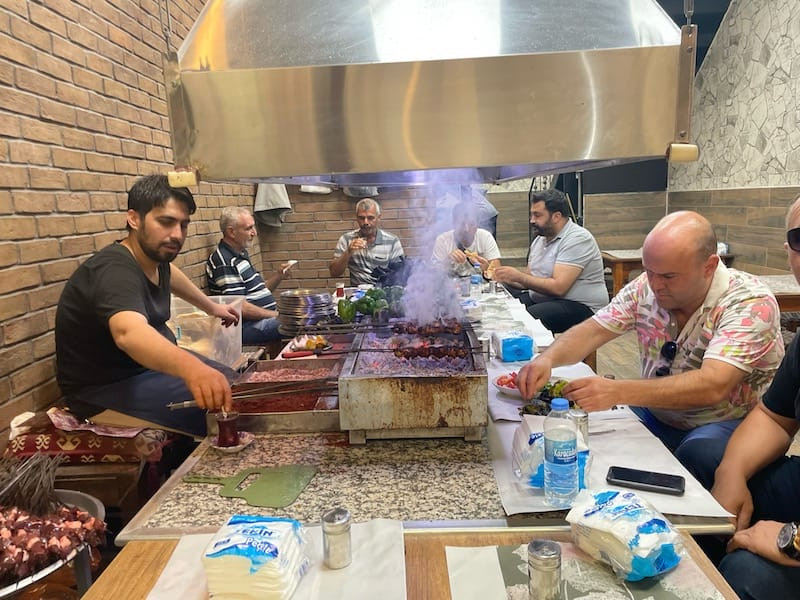
Image alt text: Husnu Cigerci, nestled amidst the bustling copper and metal workshops of Diyarbakir’s covered bazaar, offering an authentic liver street food experience.
In the bazaar’s heart, nestled amidst copper and metalworking shops, we discovered Husnu Cigerci. The air was thick with sawdust and the scent of soldering as we ordered liver skewers from the modest establishment – little more than an open grill, a few chairs, and scattered seats in the bazaar passageway. The owners seemed amused, wondering how we, as outsiders, had found their hidden gem. We mentioned a researcher friend’s recommendation, which elicited pleased smiles.
Husnu Cigerci underscored the vital role of bread in the Diyarbakir liver experience. Before the liver even arrived, the young waiter brought a steaming pile of fresh lavas. Peckish, we began nibbling, topping the bread with the now-familiar sumac and isot-coated onions. This simple combination would have been a satisfying breakfast in itself, but it was elevated by the arrival of the liver moments later.
Eating Husnu’s liver in the covered bazaar passageway was, hands down, the most immersive and authentic experience of our trip. In contrast to the bright lights of Remzi Usta, Husnu Cigerci felt undeniably “true” to the spirit of Diyarbakir’s culinary heritage. The liver itself was also exceptional, intensely flavorful and spicy. Generously coated in pepper and brushed with butter, the meat possessed the characteristic sweetness of ultra-fresh liver, incredibly tender and soft. The restaurant prides itself on this freshness, serving customers only until the daily supply of fresh liver runs out, typically shortly after lunchtime. In Diyarbakir, securing truly exceptional liver often means rising with the sun.
Ramazan Cigerci: A Quick and Flavorful Stop
En route to our final destination, we briefly stopped at Ramazan Cigerci, a shop tucked away down a side street just off the bazaar, recommended by a tour guide friend. We found Ramazan Usta himself outside, expertly threading fresh liver onto skewers. Beside him, vats of milky fresh liver and piles of peppers and tomatoes awaited their turn on the grill. As he finished each skewer, he passed it inside to his team, who slid it onto the smoking grill.
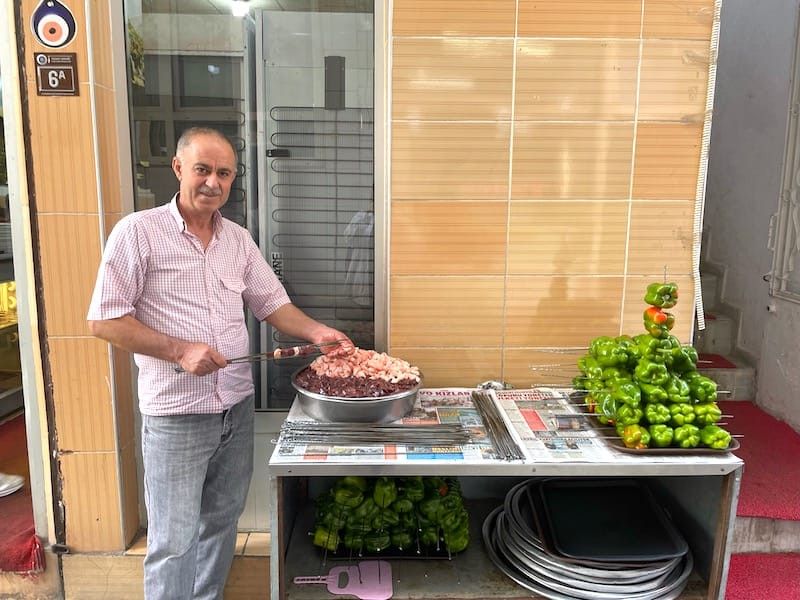
Image alt text: Ramazan Usta skillfully preparing fresh liver skewers outside his unassuming shop, Ramazan Cigerci, a hidden gem on Diyarbakir’s vibrant liver street.
The shop exuded the unassuming charm we often seek, inspiring confidence in the food’s quality. This intuition proved correct. We grabbed a liver durum – a wrap – to go and shared it as we walked away from the old city, the flavorful oil dripping down our wrists onto the sun-baked pavement below.
Cigerci Apo: Saving the Best Liver for Last
We deliberately saved what was touted as the best for last. Cigerci Apo, near the city hall, was highly recommended by a friend who considers himself a “Diyarbakir foodie.” We attempted to visit every day upon our arrival, only to find it closed, the staff apologetic. Similar to Husnu, Apo only serves liver while it’s impeccably fresh, typically only until midday. Finally, on our last day, before our flight, we arrived at Apo early in the morning, as promised to Abdullah (Apo) Usta the day before.
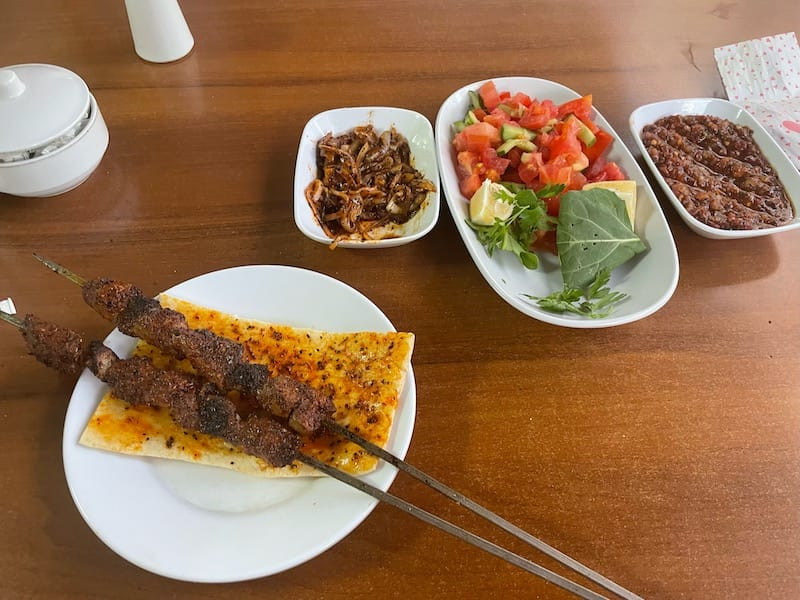
Image alt text: Abdullah Usta, the owner of Cigerci Apo, expertly grilling liver to perfection, continuing the legacy of Diyarbakir’s famed liver street food tradition.
After three days of near-exclusive liver consumption, our enthusiasm was beginning to wane. By the time we reached Cigerci Apo, we were almost hesitant to eat more. Abdullah himself welcomed us outside his restaurant, nestled at the base of an apartment building. He sat with us, sharing his story – he grew up in Diyarbakir and began working at Xale Meheme as a teenager. He spent 11 years there, starting in 1968, before opening his own establishment. When he spoke of Meheme Usta, his eyes welled up with respect, stating that Meheme had taught him everything he knew, and his sole aim was to uphold his mentor’s teachings.
He invited us to the grill, demonstrating his liver preparation technique. Like the other restaurants, he skewers liver and fat, coats them in spices, and places them over the grill. However, Apo’s signature touch involves a brush soaked in fresh melted butter, which he liberally lathers over the meat as it cooks, followed by an extra sprinkle of spices. He carefully turns the liver over the coals, repeating the process on the other side.
The result was, unequivocally, the best meal we had experienced in months. We used the fresh, spiced bread, briefly placed over the liver at the last moment to absorb its aromas, to coax the succulent chunks of meat off the skewer. We topped it with a touch of onion, fresh herbs, and raw onion. The warm bread was soft, the meat incredibly tender and buttery, the herbs and onion perfectly complementing the richness. Words failed us after the first bite, then we took another, and another. We ended up devouring three skewers each, as Abdullah watched, beaming with pride.
What’s the secret, we asked, completely stuffed? “Fresh liver,” he replied, smiling knowingly.
By Erin O’Brien, Photos by Erin O’Brien
Published on November 08, 2022
